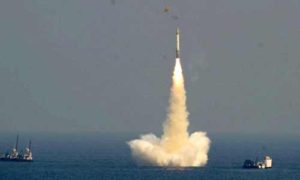By: Ahyousha Khan 25/6/2018
South Asian security architecture is complex and comprises traditional and non-traditional threats. However, conventional security threats which are of strategic nature hold the center stage within the overall regional security and threat matrix.
The destructive power of nuclear weapons gives them the psychological edge over the enemy, and if both sides possess these weapons, the mutual vulnerability keeps enemies at bay due to the fear of unacceptable damages/ loss. Deterrence is not the use of nuclear weapon instead it is the ability and capability to use the weapon if one’s vital interests are threatened. However, deterrence pessimist believes that as it is a fact that the deterrence is psychological, it is much dependent on validation of deterrence capability from time to time through finite actions. Hence, states either needs to develop new technologies or show their resolve to use nuclear weapons to keep up the credibility of nuclear weapons.
However, one aspect to make nuclear deterrence work effectively is the realization of the fact that once nuclear weapons are acquired, the states mostly try to maintain the deterrence acquired either by hook or crook. Thus, it is a futile effort if one party or parties in the conflict try to overcome it. Pakistan is an example that is maintaining nuclear deterrence with its limited resources to counter the enemy which is more significant, stronger and is greatly accepted by the international community. The reason behind Pakistan’s firm resolve is its fear that without nuclear weapons its core national interests and survival would be at stake. Thus, international pressure is of no importance because nuclear deterrence is ensuring the existence of a state. The darker side of nuclear deterrence is that to keep its credibility against one’s rival, states invest in weaponization, which leads to the arms race that stimulates security dilemma between nuclear rivals.
In the South Asian context, India, under its larger economy and geography wants to have a stronger position in the region, which is continuously challenged by Pakistan. However, to curb Pakistan and prove its worth, India develops new technologies and explores new horizons in the arms race. One such background in this regard is the Indian Ocean which is becoming the latest victim of this decade’s old South Asian rivalry. Recently India made its second SSBN and also operationalized its submarine launch K-15 missile. Moreover, Indian navy is building indigenously built SSBNs, SSNs and ship launch cruise/ballistic missiles to have maximum control over the Indian Ocean, which is falsely believed by India as its backyard.
These actions by India gave it entirely credible second-strike capability which negated the established deterrence equation between both South Asian nuclear neighbors. Resultantly, to maintain nuclear deterrence through minimum but credible efforts, Pakistan resorts to developing its second-strike capability. At the moment Pakistan has successfully tested its sea-launched cruise missile Babur-3 from a submerged platform. Moreover, it is also upgrading its Augusta 90 B series submarine with air propulsion. Furthermore, Pakistan is also buying conventional submarines and frigates from China to counter Indian SSN and SSBN fleets. In addition to this Pakistan recently tested its ship launch cruise missile Harba, which is quite a significant development because cruise missile capable of carrying nuclear weapon is already tested and with a successful test of Harba capability to fire cruise missile from the ship is also acquired. Thus, to counter growing offense by full spectrum deterrence, the option of converting ship launch cruise missile into ship launch nuclear cruise missile can be acquired by Pakistan.
Thus, disrespect of strategic deterrence by India is catalyzing arms race in the region. Saddening aspect in this regard is when rest of the world is using oceans for regional integration; the South Asia nuclear neighbors are converting their economic opportunity into a war zone. Thus, militarizing and nuclearizing the everyday goods such as the ocean. On top of all this, major powers are also using the Indian Ocean to display their power either through the actual presence of naval forces through the support of their respective allies. The fact to reckon here is that the deterrence acquired in South Asia is here to stay. Nuclearizing new arenas will not make either party more secure instead it will give birth to security dilemma, which will result in more and more arms build-up. So, to stop arms race and action-reaction chain, it is necessary that fear of unacceptable loss/damage must be respected.

